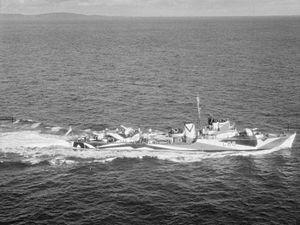HMS Lamerton (L88)
 Aerial photograph of HMS Lamerton in September 1941
| |
| History | |
|---|---|
| Name | HMS Lamerton |
| Ordered | 3 September 1939 |
| Builder | Swan Hunter |
| Laid down | 10 April 1940 |
| Launched | 14 December 1940 |
| Commissioned | 16 August 1941 |
| Identification | Pennant number: L88 |
| Honours and awards |
|
| Fate | Loaned, then sold, to Indian Navy |
| Name | INS Gomati |
| Namesake | Gomti River |
| Acquired | April 1958 |
| Commissioned | 24 April 1953 |
| Decommissioned | 1975 |
| Identification | Pennant number: D93 |
| Fate | Scrapped |
| General characteristics | |
| Class and type | Type II Hunt-class destroyer |
| Displacement |
|
| Length | 85.3 m (279 ft 10 in) o/a |
| Beam | 9.6 m (31 ft 6 in) |
| Draught | 2.51 m (8 ft 3 in) |
| Propulsion |
|
| Speed |
|
| Range | 3,700 nmi (6,900 km) at 14 kn (26 km/h)[1] |
| Complement | 164 |
| Armament |
|
HMS Lamerton was a Type II Hunt-class destroyer of the Royal Navy. She was sold to the Indian Navy in 1952, where she served as INS Gomati.
Following the war, early in 1946, she was reduced to Reserve status at Harwich.
Lamerton was ordered on 3 September 1939 under the 1939 War Emergency Build Programme. She was laid down as Job No. J4142.[2] She was commissioned on 16 August 1941.
Operation Torch
Lamerton was present at the Allied invasion of North Africa, known as Operation Torch, as part of Force H. At 1045 on 6 November 1942, after passing through the Strait of Gibraltar, the screen of Force H was augmented by the arrival of Lamerton, along with Acute, Algerine, Alarm, Albacore, Cadmus, Speedwell, Hussar, ORP Błyskawica, Wilton, and Wheatland, whilst Ibis, Enchantress, Clare, Broke, Malcolm, Wrestler and Vanoc were detached to join convoy KMSA 1.
At 1230 on 6 November, the Spanish fishing vessel Jesus Dei Gran was sighted to the south-east.
At 2230 on 7 September,
Along with Bedale and Chiddingfold, Lamerton was leased to India in 1952, as recompense for the Royal Navy not supplying a cruiser which was originally planned.[1] The three ships became the 22nd Destroyer Squadron, with Bedale (now INS Godavari) as the leader.[1] They would all require refits which were expected to cost approximately £120,000 and take around eight months.[1] The ships were initially loaned to India on seven conditions:
- India would be responsible for any work required before taking over the ships, including installing any equipment
- Armament and logistic support would be provided free of charge, but equivalent amounts were to be returned at the end of the loan period
- The standard of maintenance, and the period between refits, would be the same as when in Royal Navy service
- All additions and alterations were to be at India's expense, and subject to the approval of the Admiralty
- When the vessels were returned, they should be returned with stores, and in good condition (allowing for wear and tear)
- In the event of any loss, compensation would be payable
- That the loan would be for three years initially, subject to extension by an agreement: but the vessels would be returned if the UK needed them in an emergency - although the Royal Navy had plenty of frigates, NATO had a shortage of them.
The transfer deal was agreed by
The first commander was
The lease was extended in August 1956, and she was sold to India in April 1958.
She was deployed as a training ship until 1975, when she was struck from the active list, before being sold for scrapping.
References
- ^ ISBN 978-81-7062-148-5. Retrieved 5 January 2013.
- ^ Mason, Geoffrey. Smith, Gordon (ed.). "SERVICE HISTORIES of ROYAL NAVY WARSHIPS in WORLD WAR 2". Naval-History.Net. Retrieved 5 January 2013.
- ^ a b Burrough, Harold (March 1949). "Report on Operation Torch". Supplement to the London Gazette (38569): 1513–15.
Publications
- ISBN 978-1-86176-281-8.
- The Hunts: a history of the design, development and careers of the 86 destroyers of this class built for the Royal and Allied Navies during World War II, John English, World Ship Society, 1987, ISBN 0-905617-44-4

